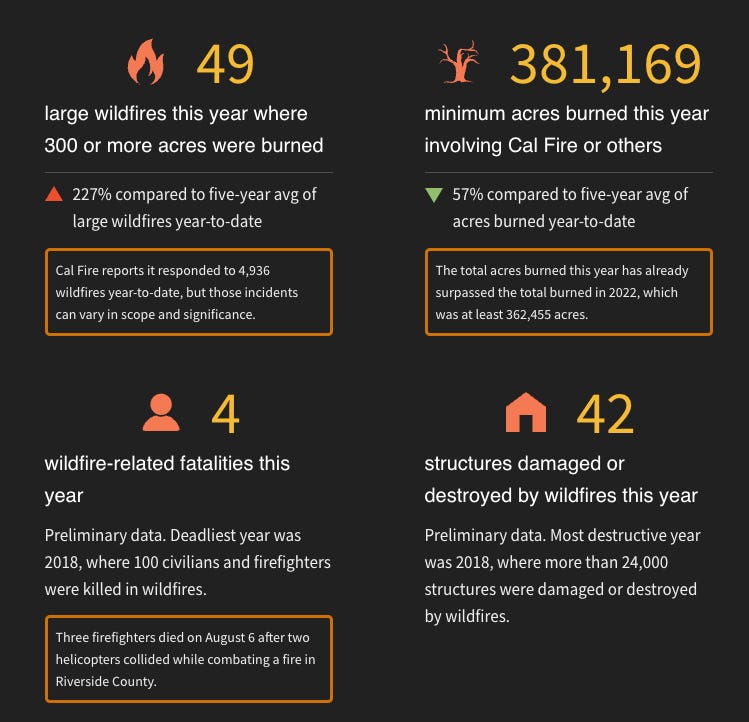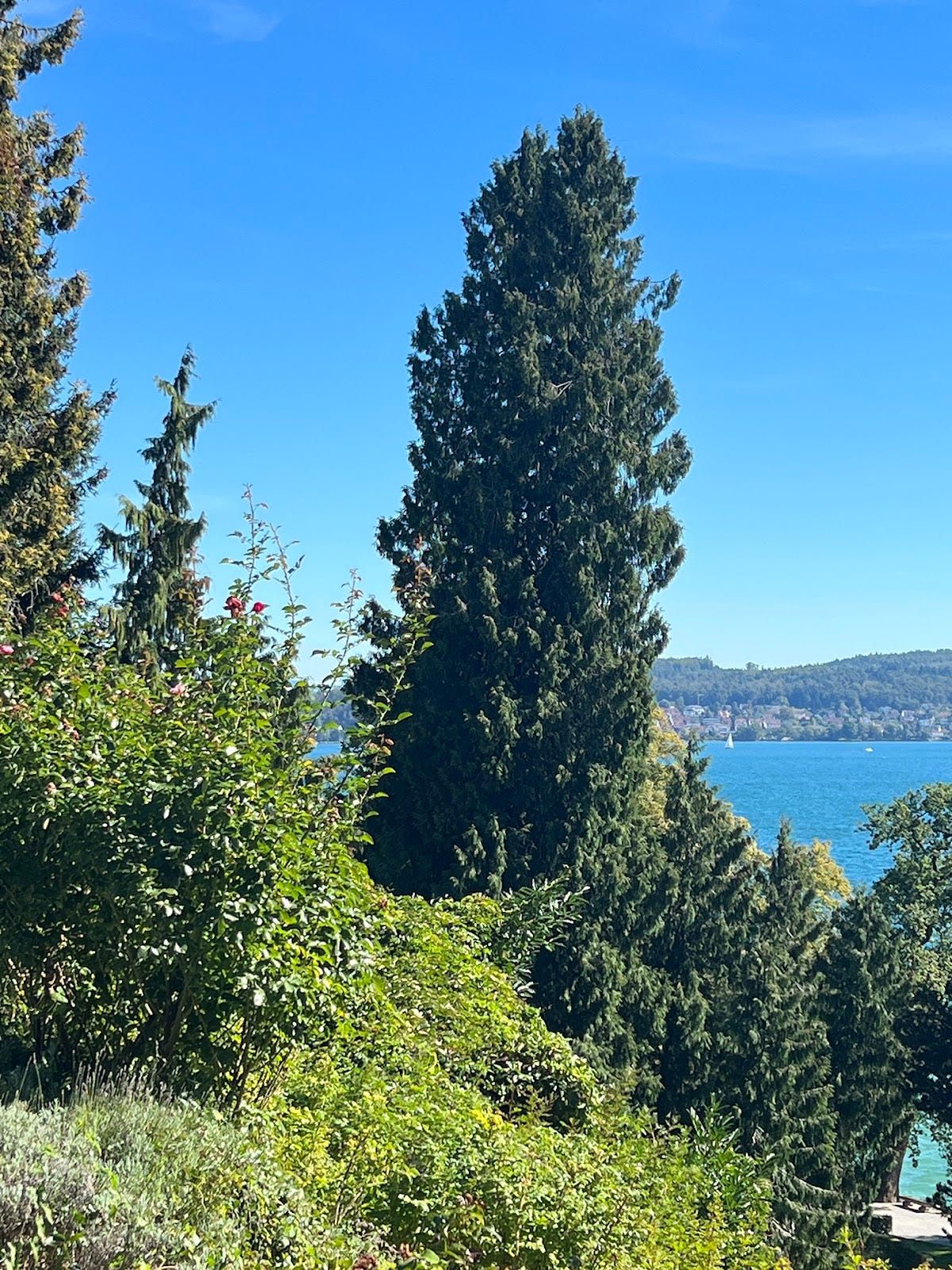Volume 2, Number 9 - Thursday, Sept. 7, 2023
Published twice a week, on Monday and Thursday

Perspective
NORTHERN CALIFORNIA, Oregon and Washington have had significant wildfires this year, but so far, fire activity in the Sierra Nevada has been relatively minimal.
Apparently, a combination of a very wet winter and spring — with additional moisture from a tropical storm — made a huge difference. Add to that increased assistance from technology, and I’ve been happily surprised that we’ve had a break from the megafires of recent years.
Even without much activity, I found the Wildfire Tracker developed by CalMatters, a nonprofit news organization, to be very interesting. You can check it out HERE.
Here’s how CalMatters introduces this effort:
In a fast-changing natural world, there are some things California fire officials can reliably count on: the unpredictability of climate-driven wildfires, their increasing size and the inevitability of new blazes. If this is war, it seems Californians are losing, with billions spent to combat fires yet an alarming rise in lives and property lost.
California’s fire season is typically from April through October. Before this year’s apparent hiatus, it seemed that it might be moving toward year-round. And, as CalMatters notes, some of the worst wildfires in the state’s history occurred outside the traditional window. The 2018 Camp Fire, which killed 85 people and destroyed the town of Paradise, was a November fire.
At any rate, there’s lots of good stuff tucked into the links and rich content pulled together by CalMatters, and I encourage you to check it out.
Redwood Fire
Here’s the latest on the Redwood Fire from Sequoia and Kings Canyon National Parks (SEKI), including the news that fire managers in the parks have identified a containment area of about 3,000 acres, which means visitors and residents of nearby areas can expect smoke to continue for some time:
Fire management staff and park leadership have elected to utilize a confine and contain strategy to manage the Redwood Fire, located in the wilderness of Sequoia National Park, near Redwood Meadow. The lightning-ignited fire was last measured at 262 acres in size and burning at low intensity through a densely forested area. It currently poses no threats to life or property.
The Redwood Fire, discovered on Aug. 15, is one of seven fires ignited by lightning throughout the parks during August, and is the only one of those that has shown any significant growth potential thus far. After the previous very wet winter and recent additional precipitation, moisture in the living vegetation has thus far done an excellent job of moderating fire behavior in the dense forest stand. The fire is burning in an area that lacks recent fire history and has the potential, especially under the current favorable conditions, to be beneficial to the landscape in this area.
You can read more HERE.
Yosemite fires
As of this morning, three other small lightning-caused fires show up on the WatchDuty map in Yosemite. The Chiquito, Deer and Wegner fires are reportedly very small (as in less than an acre) and are being monitored.
Save the Redwoods League annual report
Save the Redwoods League has published an interactive annual report online HERE.
Noteworthy efforts related to giant sequoias include:
Transfer of 160 acres of the Red Hill Grove to the Forest Service, to be managed as part of Giant Sequoia National Monument. In 2018, the organization raised $4 million to purchase the privately owned property in Red Hill Grove near the northwest corner of the Tule River Reservation.
Continued work as part of the Giant Sequoia Lands Coalition, established in 2021.
In partnership with Forest Service, led emergency restoration treatments in Giant Sequoia National Monument’s 568-acre Long Meadow Grove, home to the popular Trail of 100 Giants. From the report: “Under a stewardship agreement signed in fall 2022, the League and the Forest Service also will restore three other groves in the monument: the 533-acre Packsaddle Grove, 4,192-acre Freeman Creek Grove, and 409 acres of Alder Creek Grove. These four groves are among some of the southernmost giant sequoia groves within the monument, making them particularly vulnerable in a warmer and drier climate. The League estimates restoration of the four groves will be complete by 2026.”
Provided logistical support for prescribed burns in Calaveras Big Trees State Park. Crews treated 222 acres in and around the park’s North Grove of giant sequoias. From the report:
“These burns also demonstrated that the work that lies ahead to restore resilience to these forests after decades of poor management decisions is going to be really hard, and not without risk. Even in these carefully executed burns, two giant sequoias were significantly impacted when the fire climbed into the crown. The impact on any single tree is heartbreaking, but such potential risk is necessary for the positive ecological results of this fire and the hundreds of monarchs that are better prepared for the wildfires that are almost certain to occur.”
In cooperation with the California State Parks and Calaveras Big Trees Association, the organization unveiled a new exhibit in Calaveras Big Trees State Park in July (see photo below).
Save the Redwoods League has found itself at odds with some other environmental organizations in its continued support for the Save Our Sequoias Act, also addressed in the annual report with this:
“Joanna Nelson, PhD, League director of science and conservation planning, served as co-chair of the Giant Sequoia Land Coalition’s Learn team, helping to create a comprehensive action plan for investigating sequoia health and ecology in these times of rapid change, documenting fire behavior and tree mortality, completing post-fire assessments, and investigating the role of Western cedar bark beetles as an emerging threat to sequoias. Nelson also provided expert insight on the Save Our Sequoias Act—bipartisan legislation that would enable emergency action to use preventative, active management and stewardship in forests to protect giant sequoias from severe wildfire and other threats. She provided testimony in a House Natural Resources Committee Forum in July 2022. Her recommendations drew on studies by League and affiliated scientists, which showed that active restoration management reduced the risk of giant sequoia mortality.”

Wildfire, water & weather update
There are no weather watches, warnings or advisories in the Sierra Nevada this morning, with pretty nice weather in the forecast. The best Sierra Nevada weather forecasts can be found at NWS Hanford, HERE, and NWS Sacramento, HERE.
Wildfire update: Here’s the federal Situation Report for today. Across the country this morning, there are 55 uncontained large fires, in addition to 31 fires being managed under a strategy other than full suppression, both down from Monday.
In California, not much has changed with WatchDuty HERE, and it shows most of the large fire activity in the state remains still in the north. Rain has helped, and there has been an increase in containment with the largest of the fires — the Smith River Complex that has plagued the California-Oregon border for weeks at 85,520 acres with 19% containment as of the latest report yesterday.
CalFire’s incident page this morning shows 5,122 wildfires this season, with 257,220 acres burned. There have been four fatalities this fire season — one civilian and three firefighters. Nine structures have been damaged, and 33 have been destroyed.
The Redwood Fire, discussed above, remains California’s largest active wildfire south of Redding.
Did you know you can comment here?
It’s easy to comment on items in this newsletter. Just scroll down, and you’ll find a comment box. You’re invited to join the conversation!
Giant sequoias in the news
This section will resume on Monday — not much news today!
Giant sequoia around the world
Reader Mike Hite of Three Rivers has shared more photos of giant sequoias he saw in Europe, including the one below on Mainau Island, near Konstanz, Germany (on the southern border of Germany with Switzerland on Lake Constance).
He told me the once private estate is now an arboretum run by a foundation controlled by the original family. The lush island forest has nearly 100 giant sequoias and several hundred coast redwoods with plantings beginning around 1870, Hite said.
Thanks for reading!





